Few spaces foster connection the way a dining room can, and 2025’s design conversation places that gathering spot at the crossroads of comfort, sustainability, and style. From eco-minded materials to high-tech conveniences, the newest ideas layer practicality with moments of artistry so every meal feels special. The twenty strategies below translate broad trends into clear, actionable moves you can tailor to any budget or footprint. Whether you’re refreshing paint, rethinking lighting, or re-imagining how the room functions day to night, each concept delivers a purposeful upgrade that keeps the dining room firmly at the heart of home life. Let’s explore.
1. Sustainable Materials for a Greener Dining Room
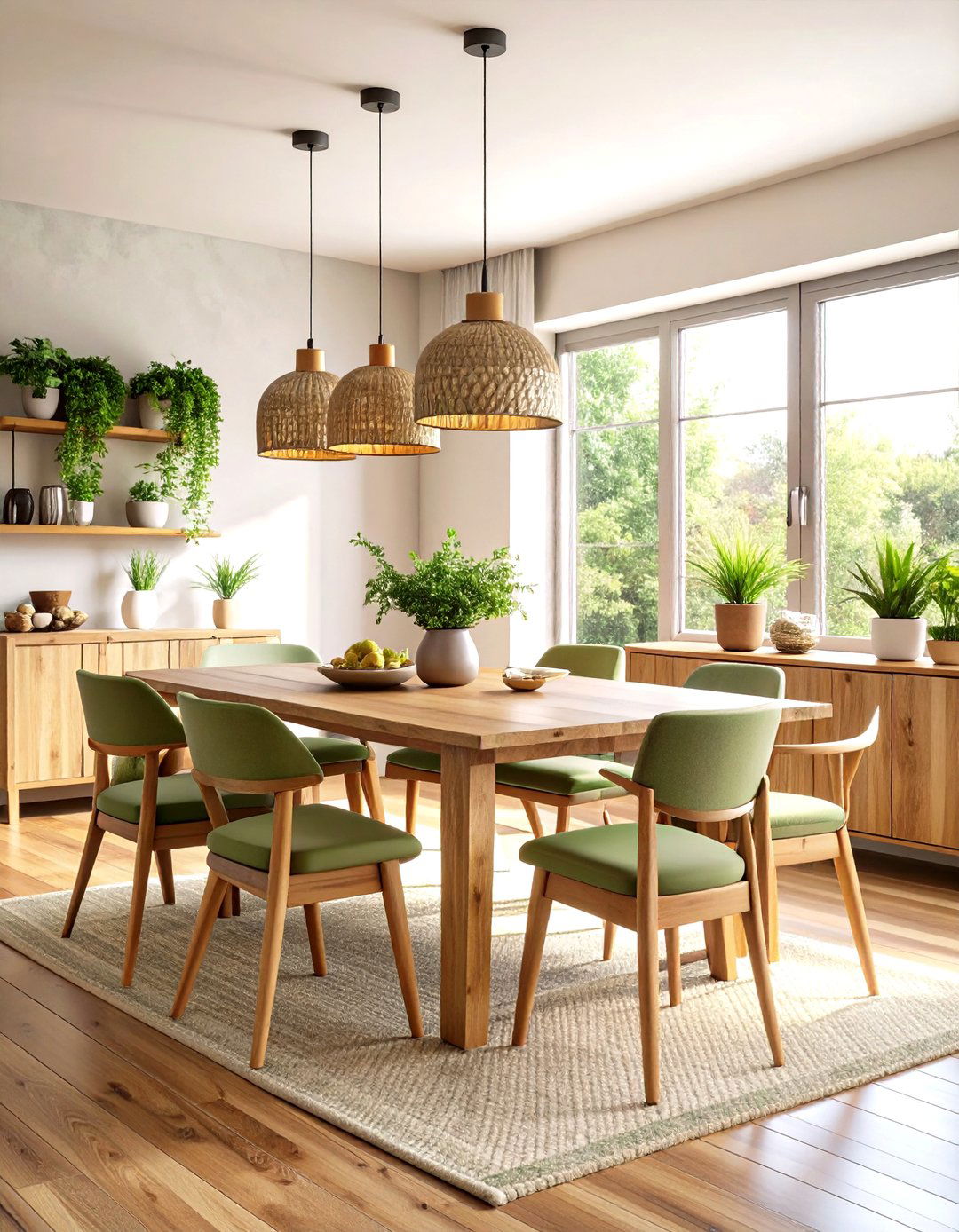
A warm, welcoming dining room starts with pieces that are kind to the planet. Reclaimed wood tables, bamboo chairs, and recycled-metal light fixtures cut environmental impact while adding unmistakable character. Current trend reports highlight how sustainable furniture has shifted from niche to mainstream, emphasizing longevity over throwaway styling. Choosing finishes certified low-VOC and textiles woven from organic fibers further improves indoor air quality. Anchor major purchases with timeless silhouettes, then accent with vintage finds to reduce demand for new resources. The result is a dining room that feels fresh today and responsible for years to come. The Good Trade Decorilla
2. Layered Lighting Elevates Your Dining Room
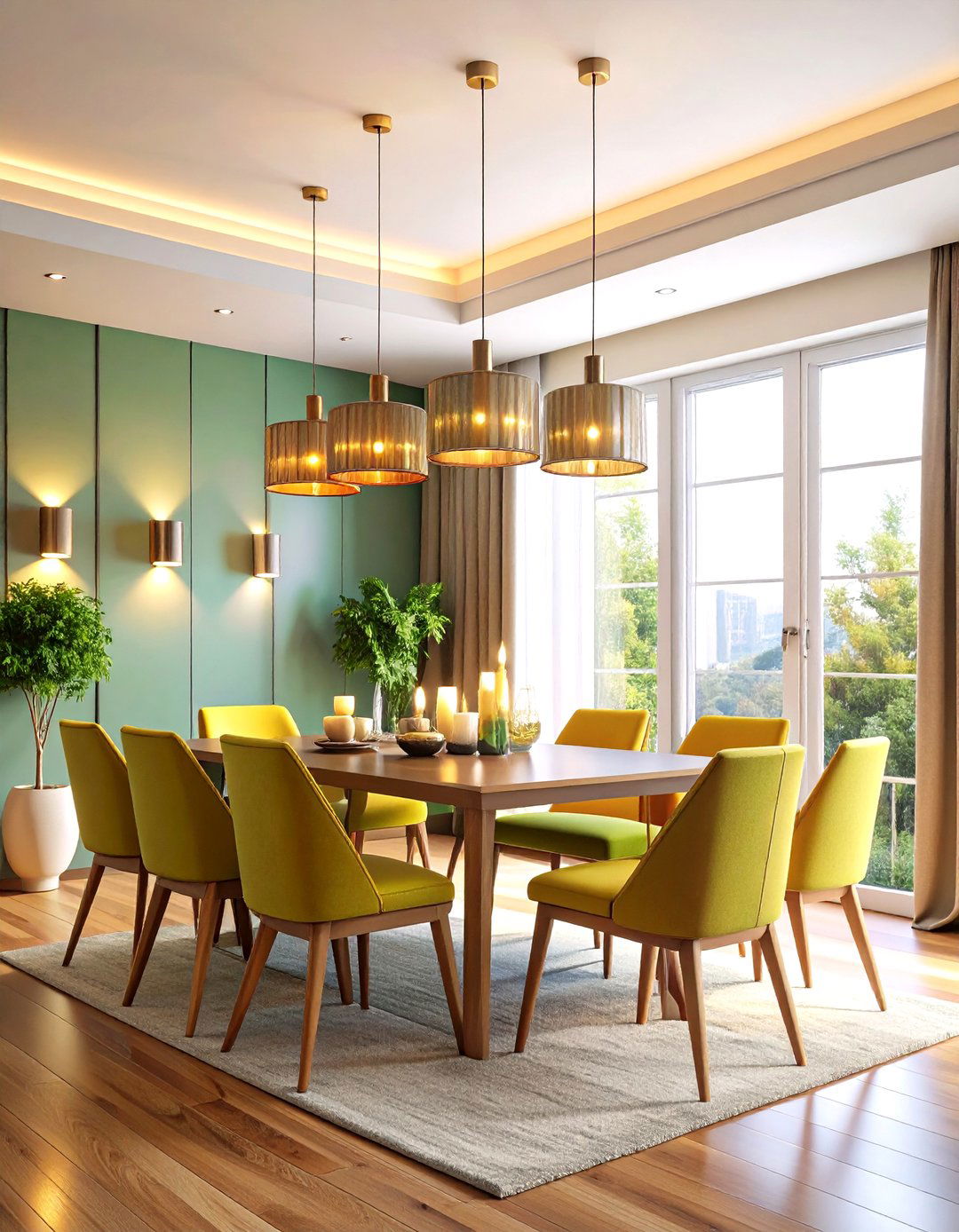
The quickest path to restaurant-level ambience is layering ambient, task, and accent light. Start with a dimmable ceiling fixture for even illumination, add wall sconces or picture lights to spotlight art, and finish with table-level candles or cordless lamps for intimacy. Designers stress that blending multiple sources eliminates harsh shadows and allows the dining room to flex from family breakfasts to evening parties with a flick of a switch. Integrated smart bulbs let you preset dinner scenes, adjusting color temperature for food-flattering warmth. Position switches within reach of the table so guests can tailor brightness without leaving their seats. Seus Lighting Decorilla
3. Bold Color Moves Energize the Dining Room
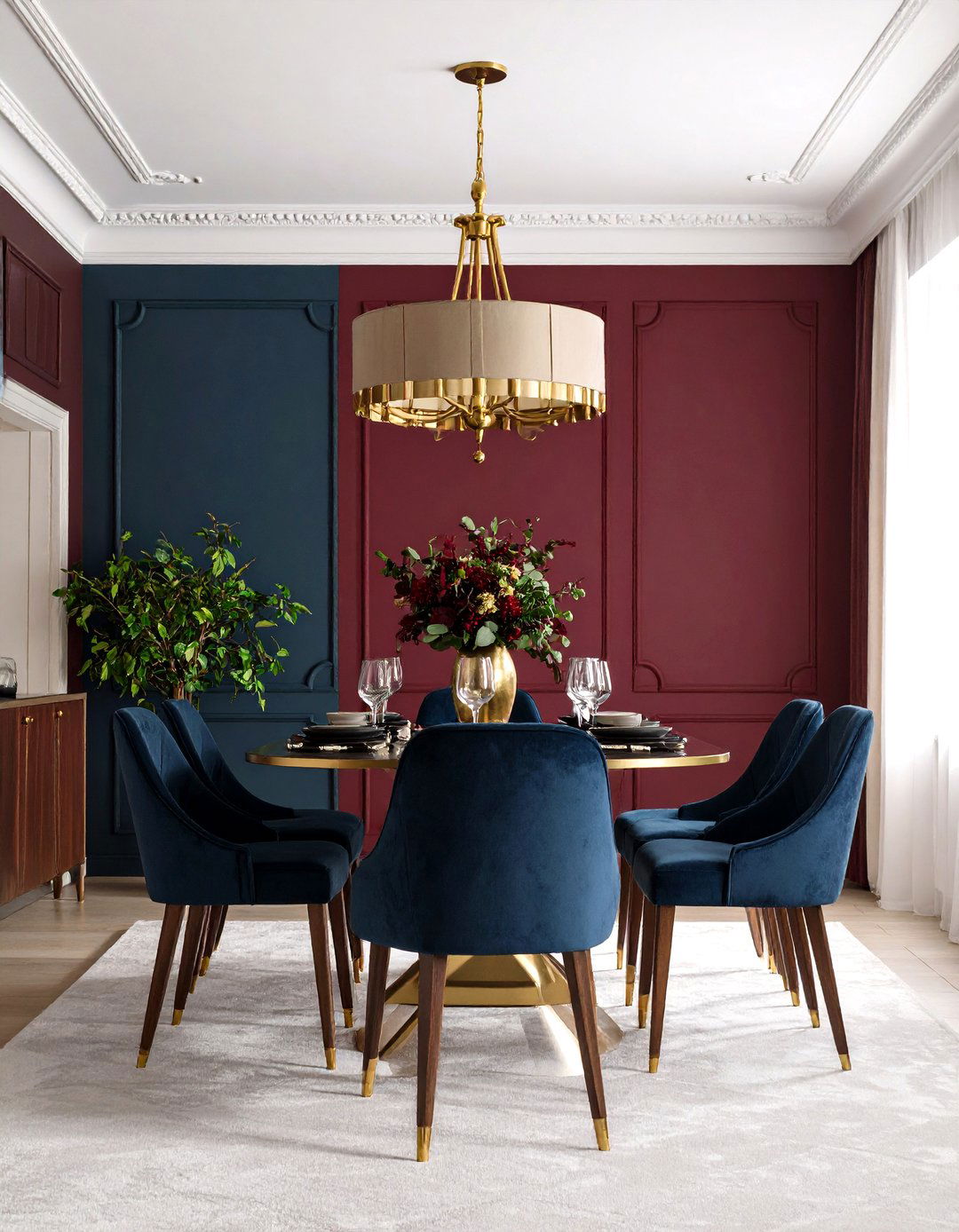
Saturated hues like forest green, burgundy, or deep navy wrap a dining room in cozy drama while making white dinnerware pop. Paint experts encourage using bolder shades here because meals naturally limit time spent in the space, preventing color fatigue. Balance richness with pale trim or a light ceiling to keep the room buoyant, or go tonal with chairs upholstered in a slightly lighter tint for a designer layer. If full coverage feels daunting, paint only the lower two-thirds of walls and cap with crisp molding to create graphic interest without overwhelming the eye. Benjamin Moore Decorilla
4. Mix-and-Match Seating Animates the Dining Room

Unlike perfectly matched sets, a curated assortment of chairs adds instant personality. Combine two head chairs in a contrasting fabric with simple side chairs, or alternate vintage wood with modern metal for tension. Pros advise maintaining one unifying element—such as seat height, finish, or color family—so the ensemble feels intentional rather than random. This approach lets you collect pieces over time, embraces heirlooms, and offers easy replacement should a chair break. Plus, different silhouettes accommodate guests of varying sizes more comfortably than uniform seats. Plank+Beam
5. Built-In Banquette Maximizes Dining Room Corners
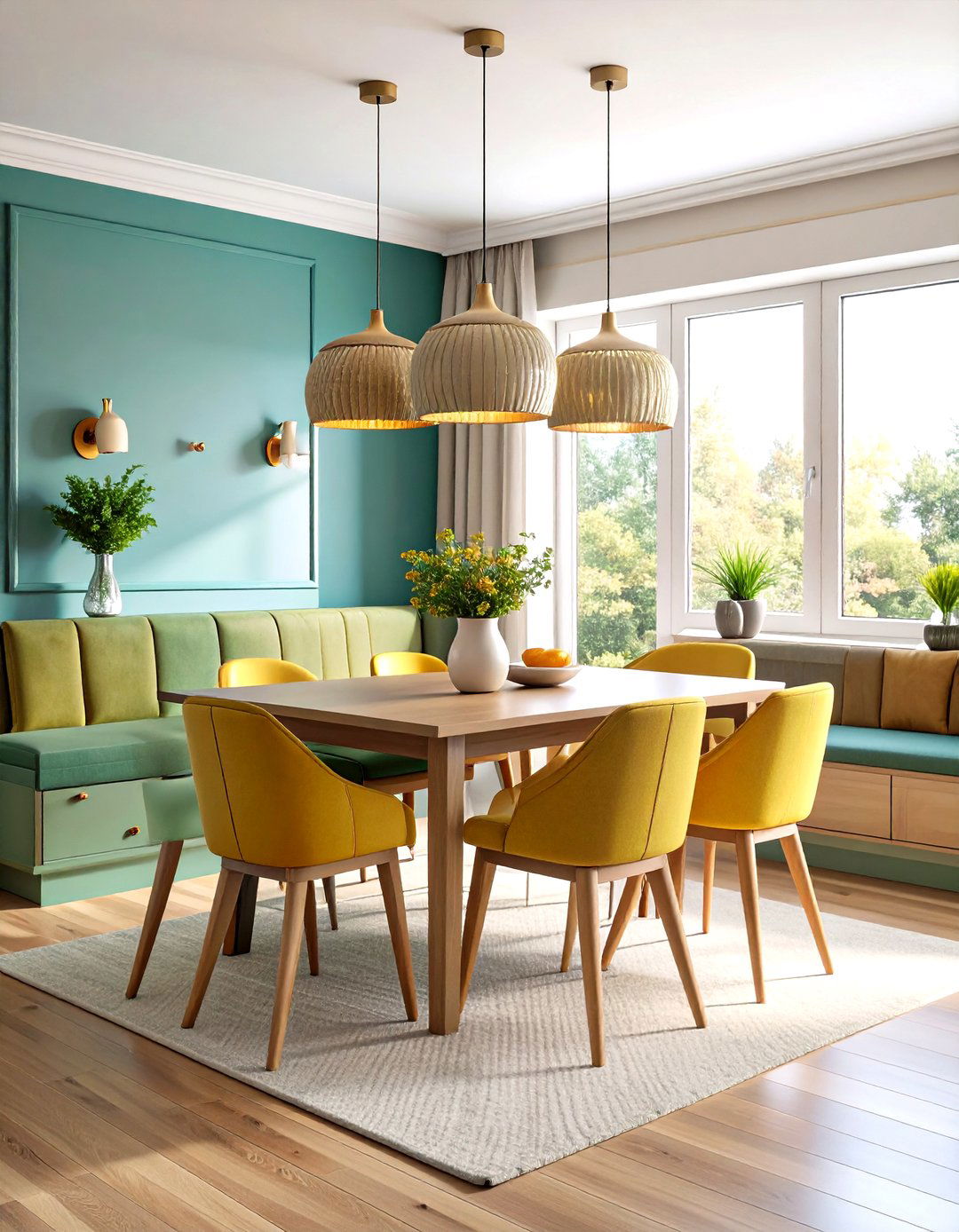
Tucking a custom banquette along one wall frees valuable floor space while delivering plush, linger-worthy seating. Storage drawers beneath the bench hide table linens or board games, making the dining room work doubly hard. Upholster cushions in performance fabric to resist spills, and run the bench past the table width so diners can slide in without awkward shuffling. Add sconces above for dedicated reading light if the nook doubles as a homework zone between meals. Elle Decor Pinterest
6. Foldaway Tables Unlock Flexible Dining Room Layouts
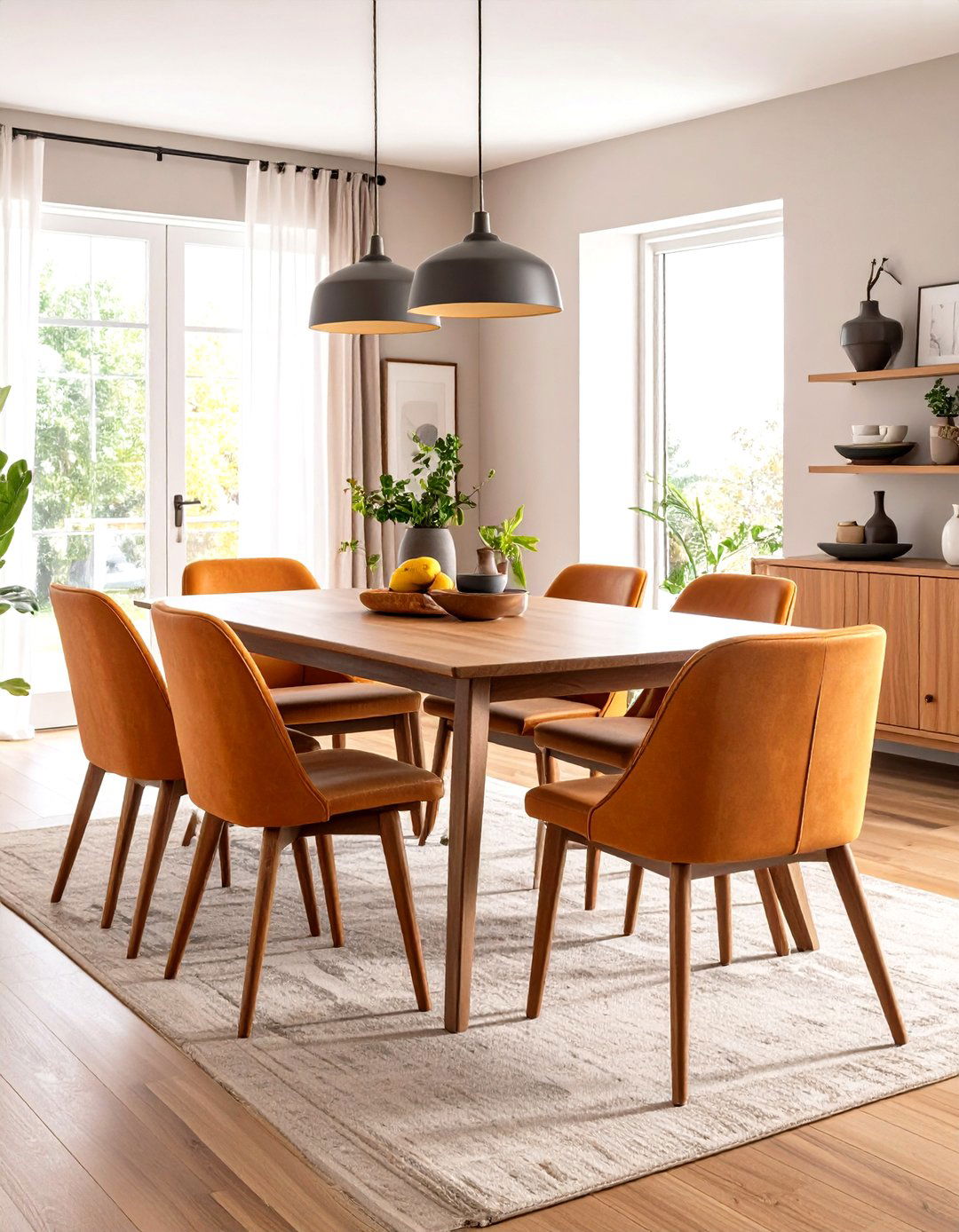
For apartments or multifunctional homes, a drop-leaf or gate-leg table provides everyday surface without monopolizing square footage. Hinged leaves swing up when extra place settings are needed, then tuck back so the dining room transitions to yoga studio or craft station. Look for sturdy hardware and locking supports to prevent wobble, and pair with stackable chairs stored in a closet. Designers suggest matching table finish to surrounding millwork so the piece feels built-in even when folded. Pinterest
7. Accent Walls Give the Dining Room a Focal Point
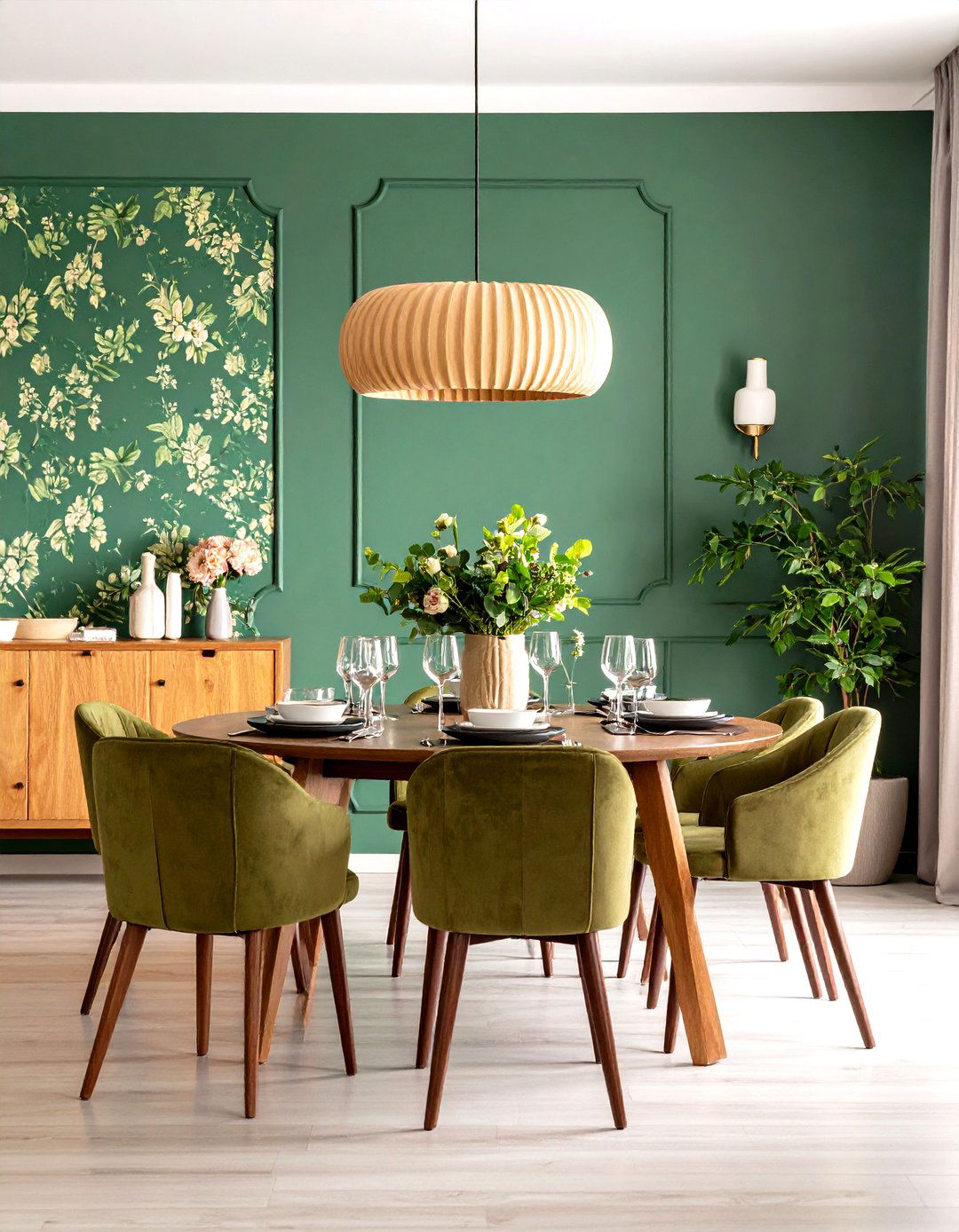
A single wall wrapped in dramatic wallpaper, lime-wash paint, or applied molding turns an ordinary dining room into a showstopper. Choose patterns that echo dish motifs or nearby upholstery so the space feels cohesive. If you entertain often, a wipeable vinyl mural stands up to stray splashes of red wine. Framing the accent with narrow picture rail allows future swaps without major repair, letting you refresh style as trends shift. Pinterest Houzz
8. A Statement Chandelier Crowns the Dining Room

Suspending an overscale fixture 30–34 inches above the tabletop draws eyes upward and centers the meal ritual. Current offerings range from airy linear LEDs to sculptural mixed-material forms, each casting distinctive shadows across plates. Match fixture width to roughly half the table length for balanced proportions. Dimmable bulbs are non-negotiable, providing bright task light for puzzles, then dialing down to candle-glow for dessert. Swap incandescent for high-CRI LEDs to showcase food colors accurately while slashing energy use. Lamps Plus House Beautiful
9. Biophilic Touch Brings Nature into the Dining Room
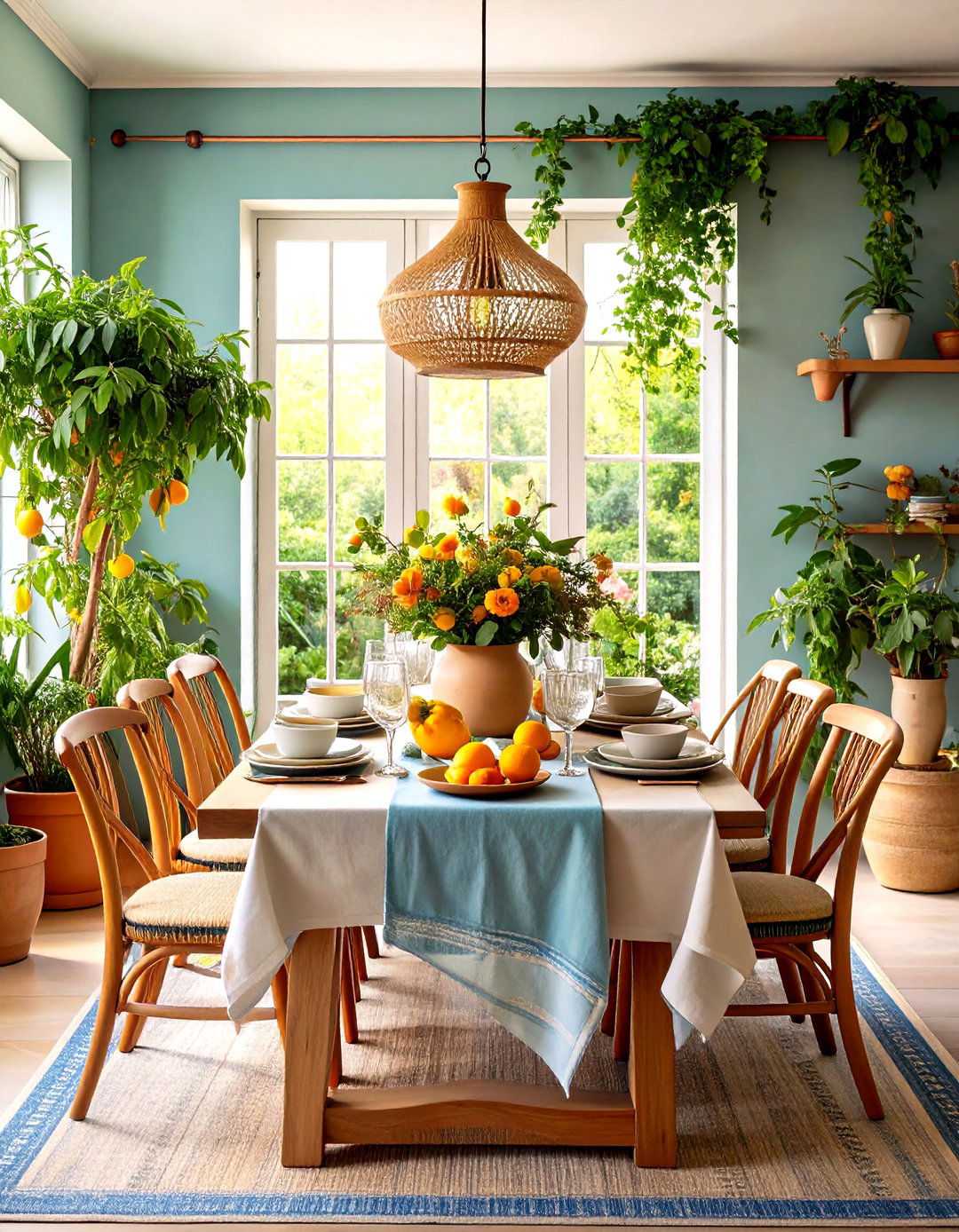
Placing potted herbs, cascading vines, or a mini citrus tree near the dining table satisfies a human craving for greenery and can even improve air quality. Biophilic research notes measurable drops in stress when natural elements enter daily view. Choose plants that thrive in your light conditions, grouping varying heights for depth. Supplement living foliage with natural materials—linen runners, stoneware plates, woven chargers—to reinforce the outdoor connection. A simple ritual of watering before meals turns maintenance into mindfulness.
10. Right-Size Rugs Ground the Dining Room
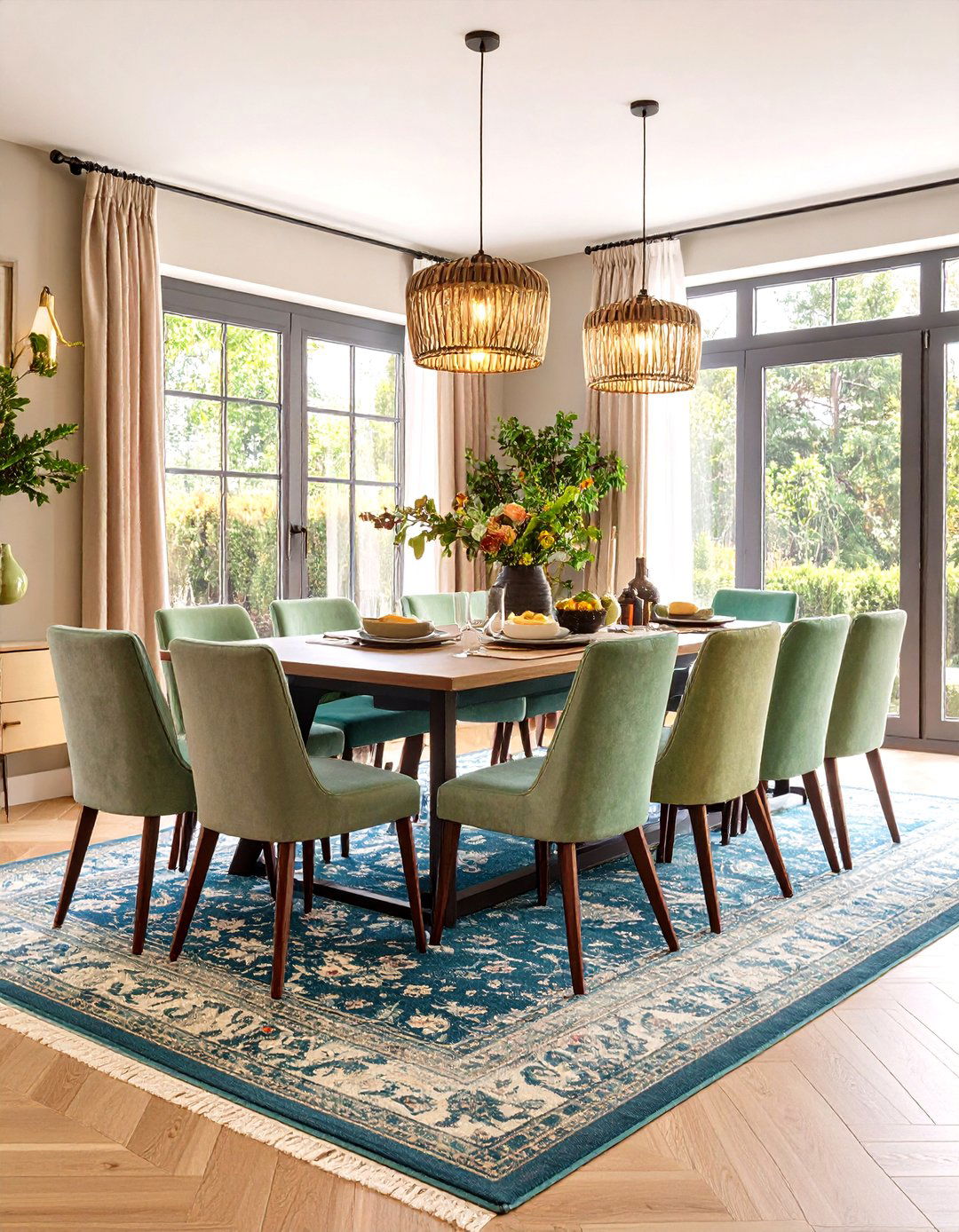
A rug should extend at least 24 inches beyond the table on all sides so chairs stay fully on-carpet when pulled out. Anything smaller risks trip hazards and uneven wear. Flat-weave wool or indoor-outdoor polypropylene handles crumbs and chair legs better than high pile. Use rug tape on hard floors to prevent shifting, and repeat one of the rug’s secondary colors in napkins or artwork for subtle harmony. Rotate the rug seasonally to distribute foot traffic and sun exposure evenly. IKEA
11. Dramatic Ceilings Add Personality to the Dining Room
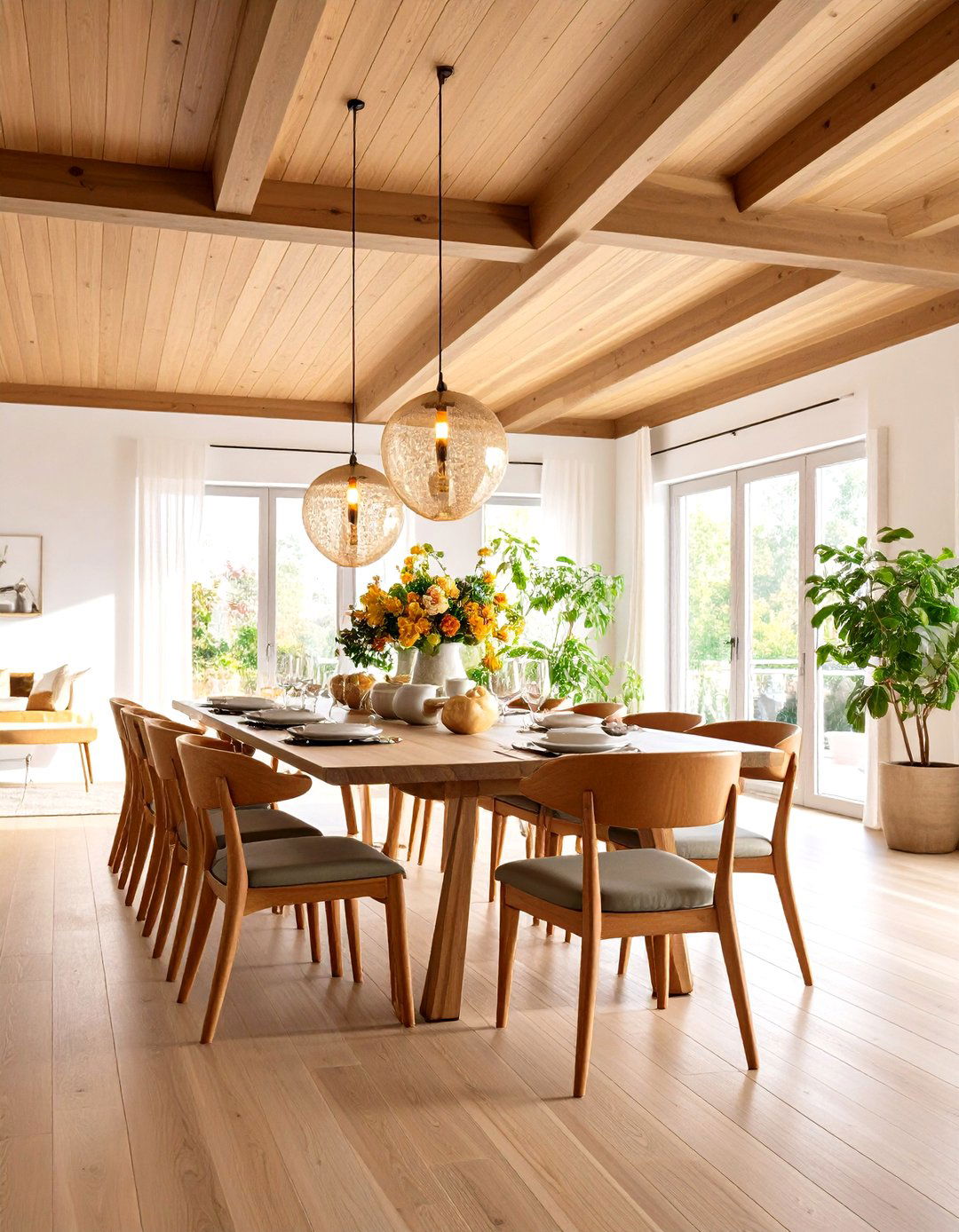
Coffered panels, painted coffers, or graphic paper overhead push style skyward without cluttering floor space. A contrasting ceiling color visually compresses tall rooms for coziness, while metallic wallpaper bounces candlelight for evening sparkle. When installing beams, align with table length to emphasize perspective. Low ceilings benefit from slim slats painted tone-on-tone to create texture without heavy volume. Always prime properly to prevent peeling in rooms prone to steam from adjacent kitchens. Houzz
12. Hybrid Dining Room Doubles as a Home Office
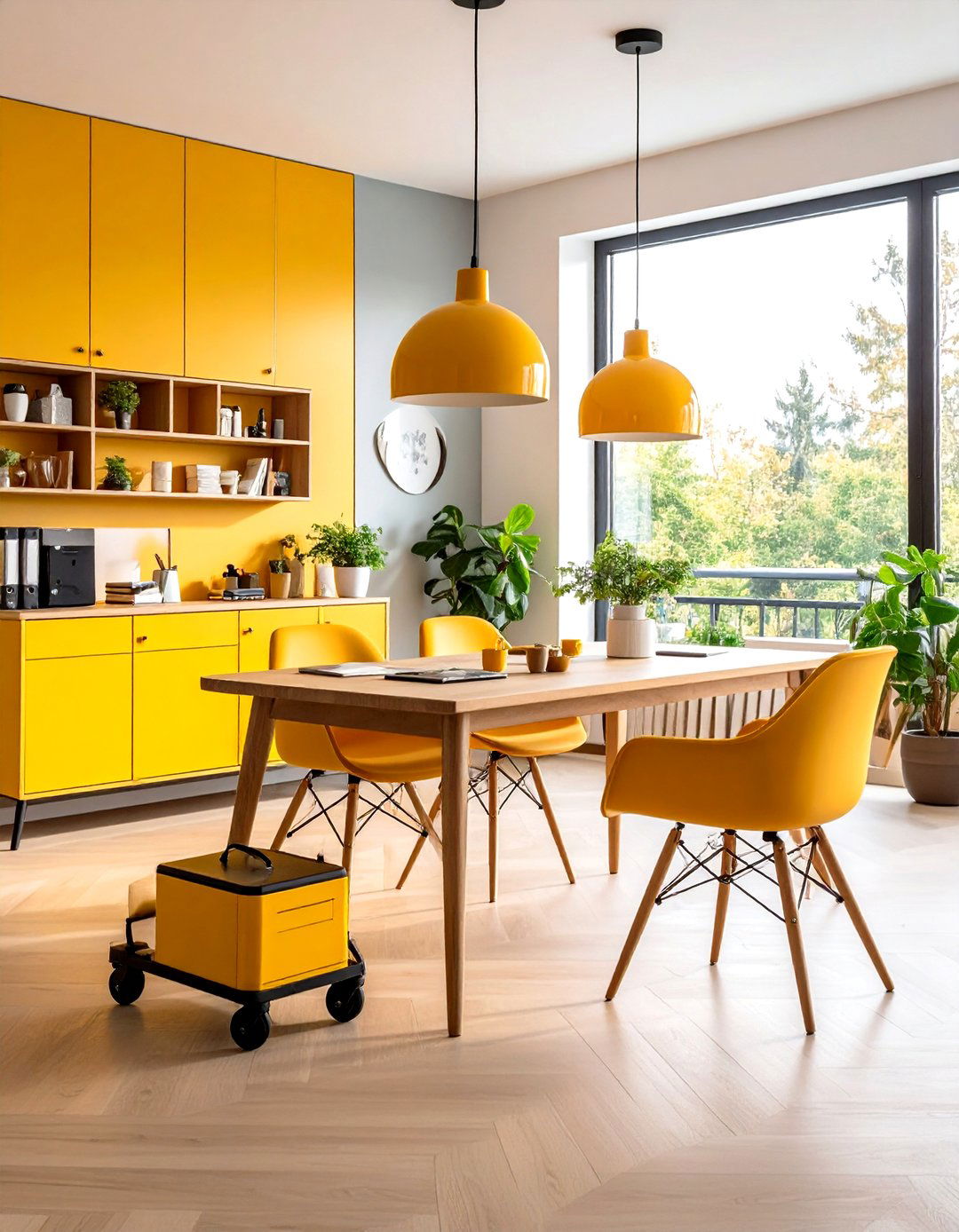
Remote work makes the dining table the hardest-working surface in many homes. Disguise office gear in a rolling cart that parks in a closet at five-o’clock, and install a pop-up outlet in the floor so laptop cords don’t snake across walkways. Task lamps with adjustable arms keep keyboards lit without changing overhead mood. Encourage posture shifts by swapping one side chair for an ergonomic task chair in complementary upholstery. A lacquer tray corrals stationery, ready to move when dinner’s on. Pinterest
13. Gallery Walls Tell Stories in the Dining Room
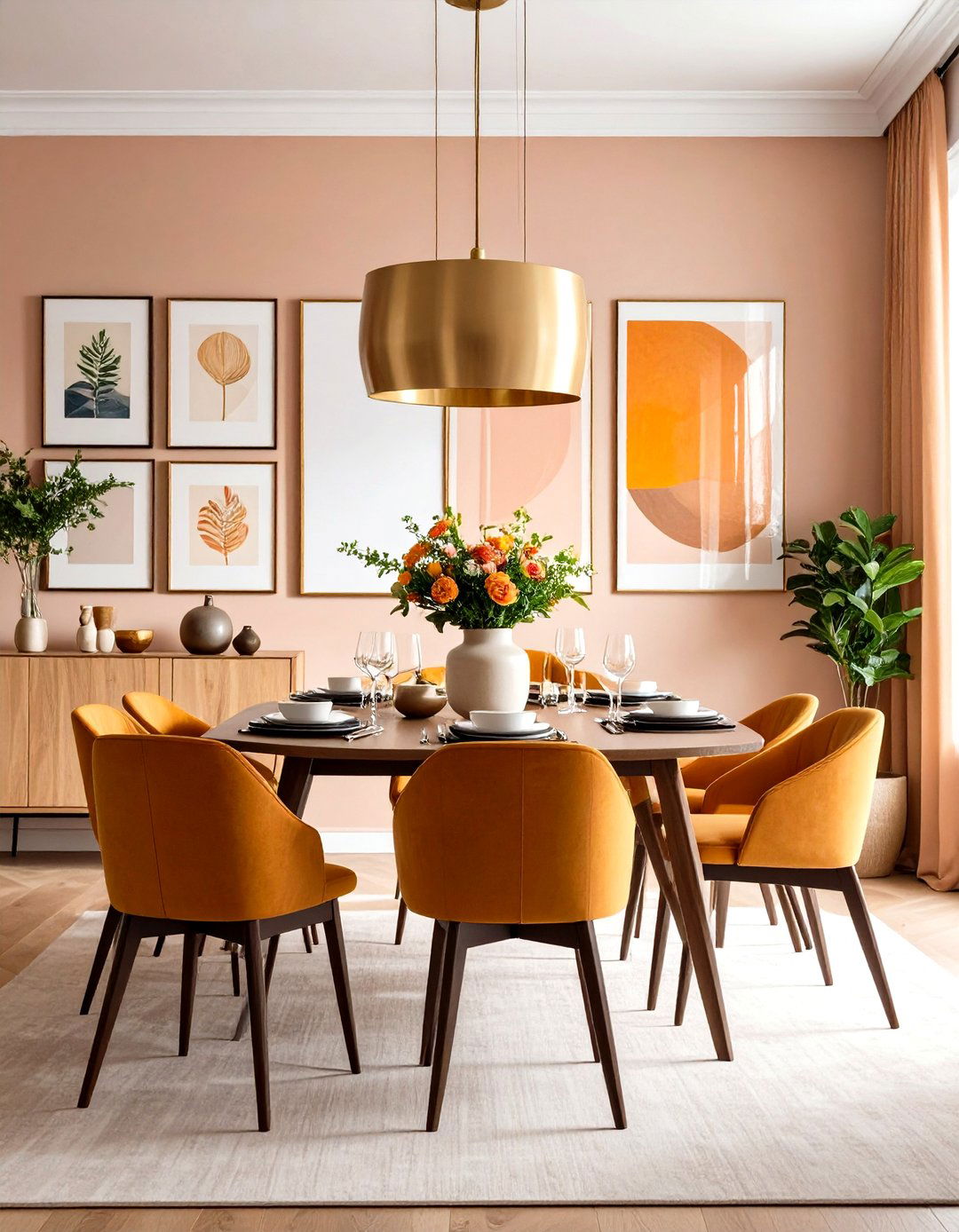
Floor-to-ceiling art creates an intimate backdrop that sparks conversation over coffee. Curate frames in different finishes but keep mat widths consistent for cohesion. Mix photography with children’s sketches or flea-market finds to telegraph personality. Install a slim picture light above the arrangement to spotlight textures, and place glass-front frames opposite windows to reflect daylight through the dining room. Command-strip hooks help you experiment without committing to dozens of nail holes. Pinterest
14. Area Rugs and Lighting Define Zones in Open-Plan Dining Rooms
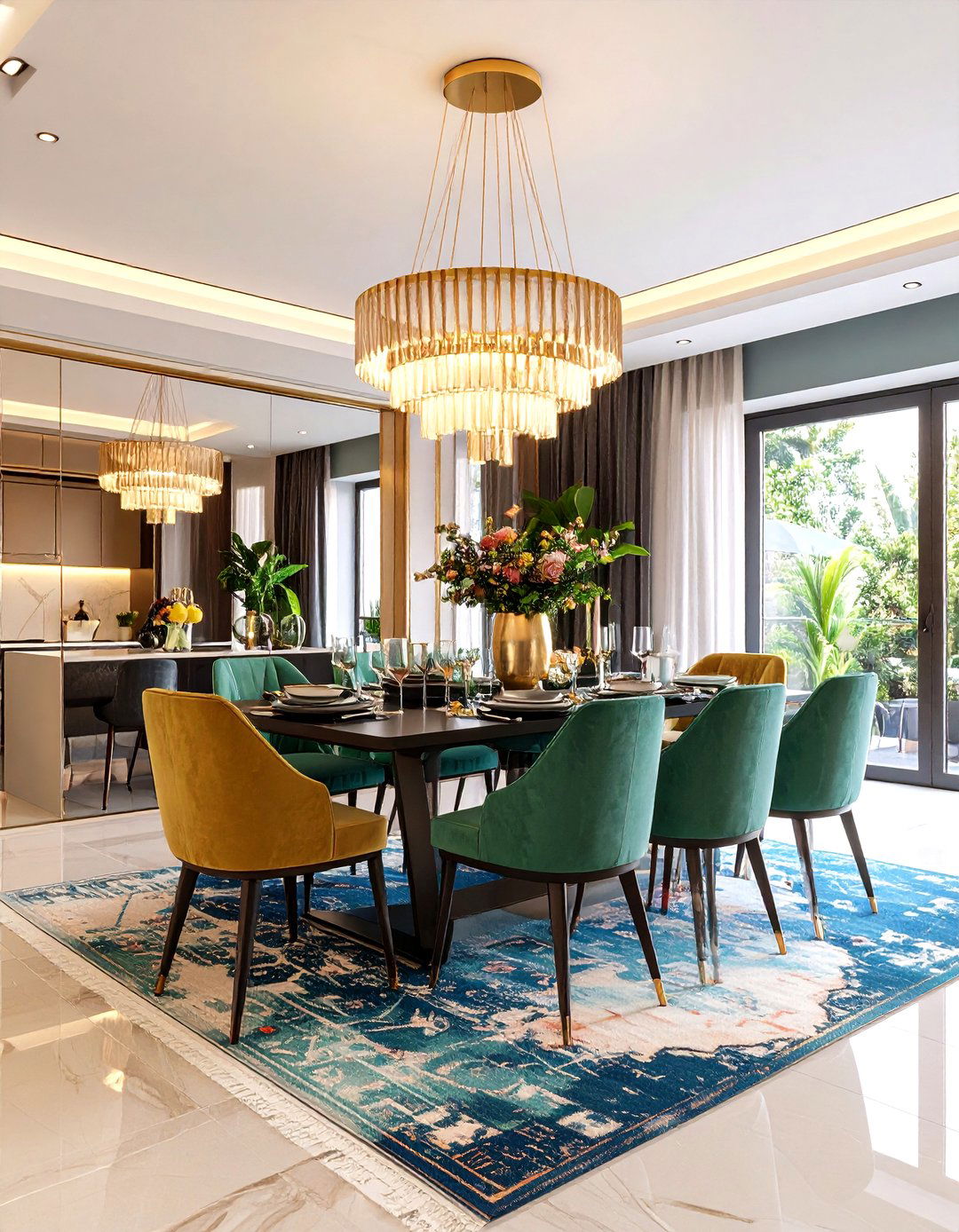
In combined kitchen-living layouts, a distinct rug and pendant visually carve the dining zone without walls. Mirror finishes or warm metallic accents on fixtures can relate to nearby kitchen hardware for unity. Designers often align the rug edge with the island countertop to create an intuitive circulation path. If ceiling wiring is tricky, install plug-in pendant kits swagged from wall hooks—an affordable hack that still centers the table beneath its own glow. Houzz IKEA
15. Wabi-Sabi Serenity Softens the Dining Room

Celebrating imperfection through handmade ceramics, weathered wood, and linen with natural slubs fosters a calming, lived-in dining room. Wabi-sabi philosophy prioritizes authenticity and transience, so let a cracked vase or uneven bowl stand proudly rather than hide it. Earth-toned walls and candlelight enhance the quiet mood, while uncluttered shelves allow negative space to breathe. This gentle minimalism pairs beautifully with slow-food rituals, encouraging guests to savor each bite mindfully. Robern Decorilla
16. Rustic Vintage Accents Warm the Dining Room
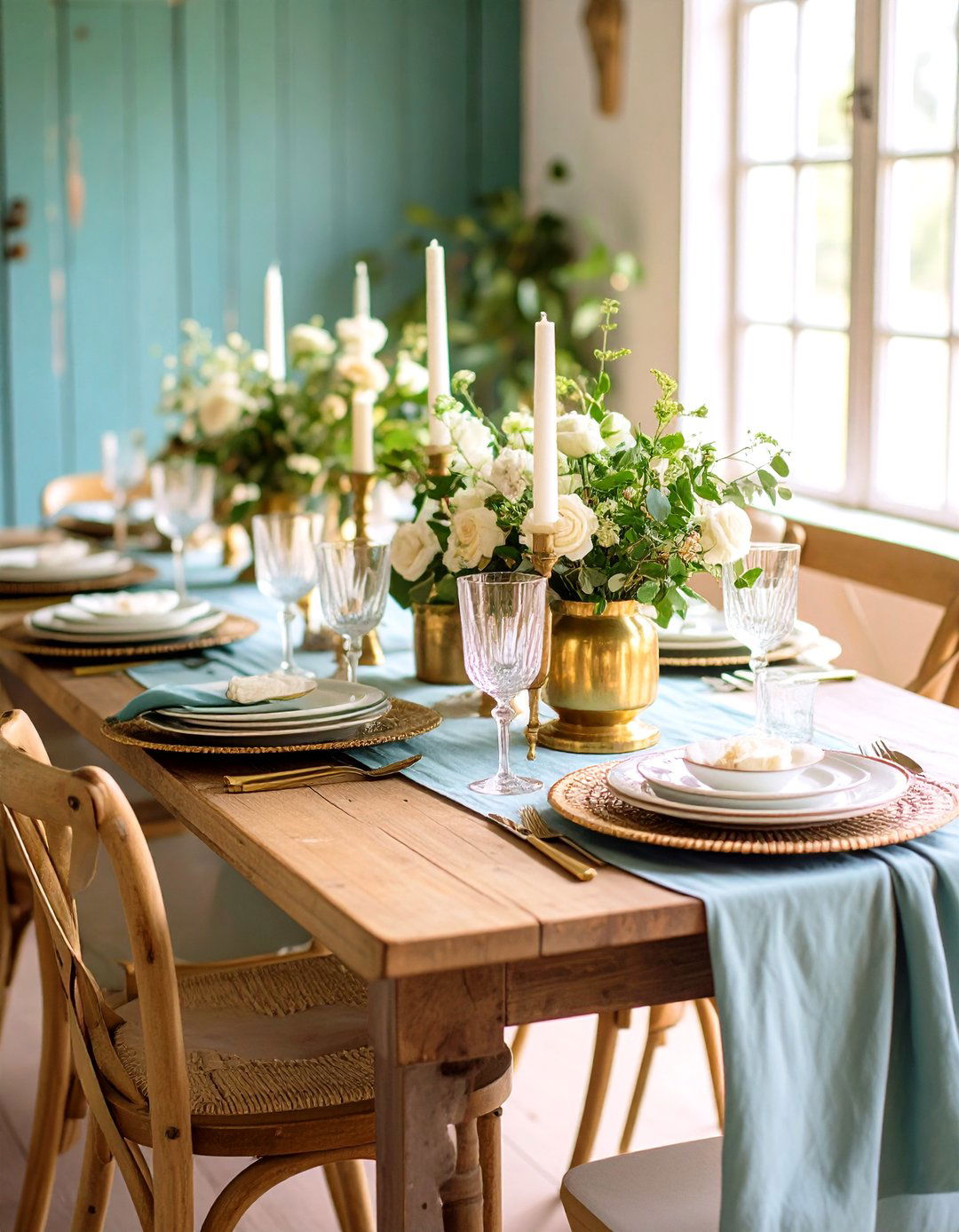
Wicker chargers, aged brass candlesticks, and salvaged farmhouse doors lend texture that trends label “rustic accents.” Woven pieces add nostalgic charm yet feel on-trend thanks to renewed appreciation for natural fibers. Mixing patinated finds with sleek flatware keeps the look curated, not kitsch. Thrifted glassware or embroidered linens inject history while supporting sustainable reuse. Layer these elements sparingly so the dining room feels collected over time, not staged overnight. Southern Living Homes & Gardens
17. Smart Tech Seamlessly Serves the Dining Room
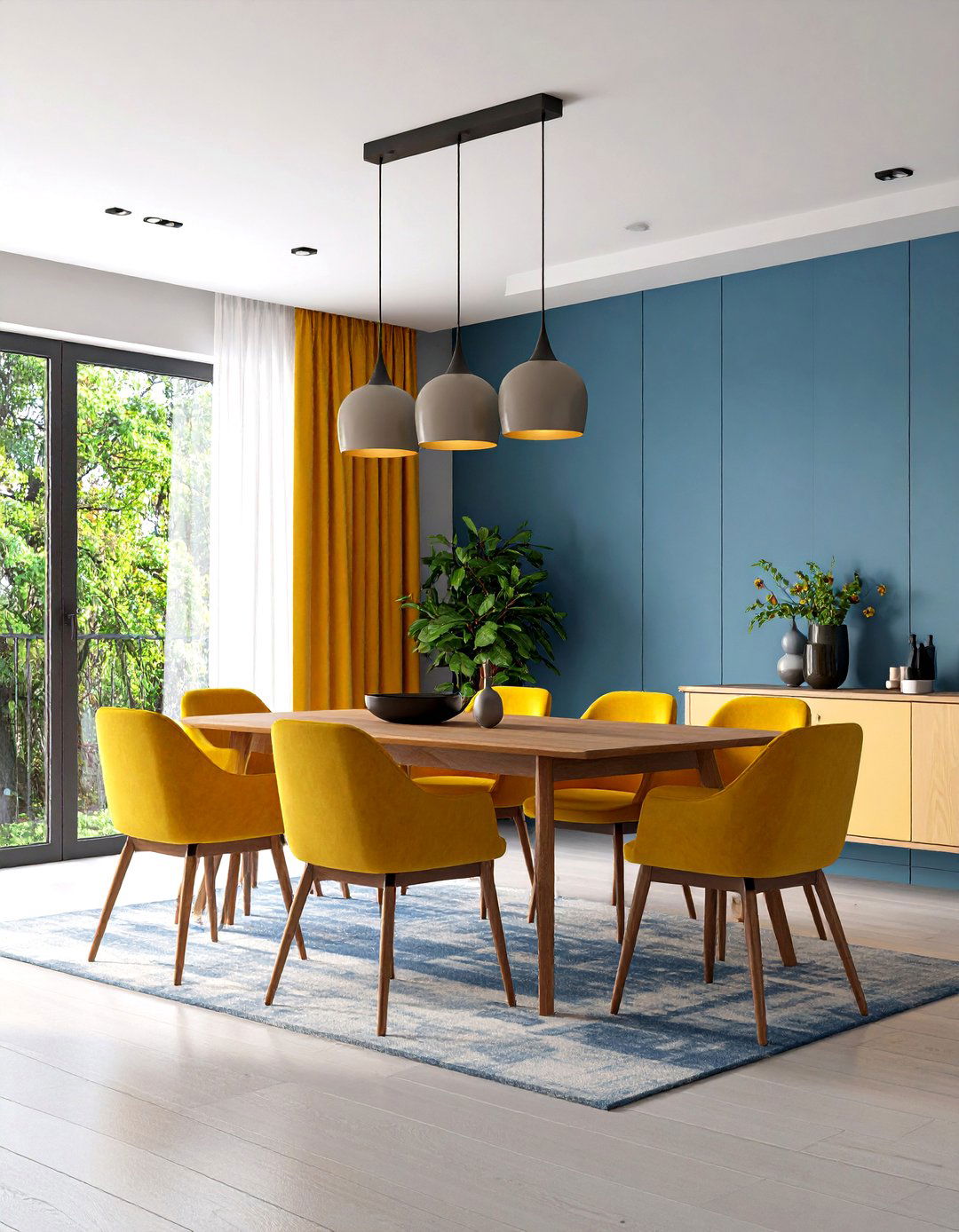
From motion-activated task lights to app-controlled motorized curtains that dim glare, discreet tech upgrades amplify comfort without shouting “gadget.” Trend analysts note rising interest in connected dining rooms where speakers cue playlists and voice assistants trigger lighting scenes. Conceal hubs inside sideboard drawers and use neutral faceplates to blend outlets. Opt for updates that still work manually so guests unfamiliar with the system aren’t stranded in the dark. Decorilla
18. A Styled Sideboard Organizes the Dining Room
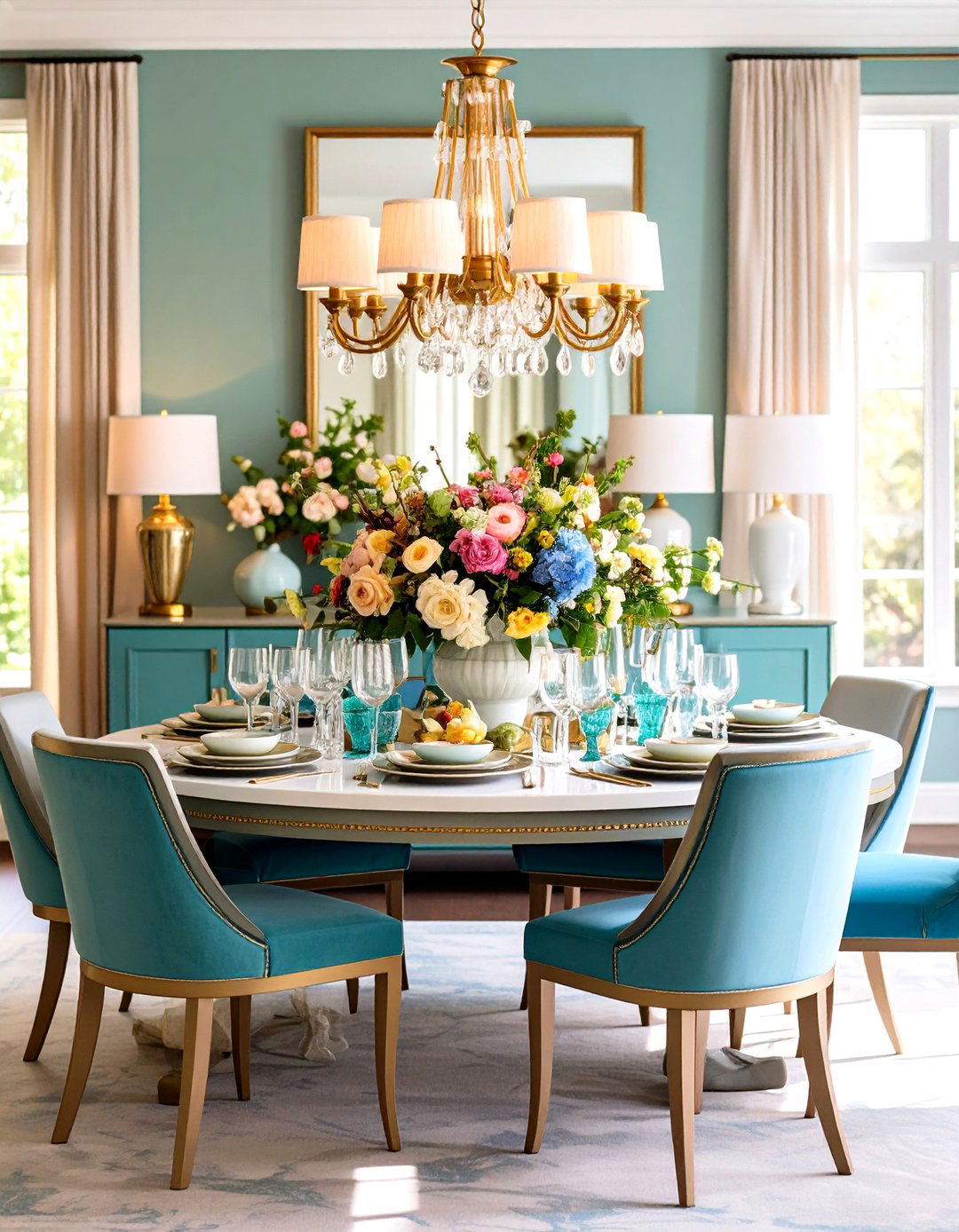
Treat the sideboard top as a horizontal gallery: anchor each end with matching lamps for symmetry, stack serving platters vertically on stands for height, and layer art or a mirror just above for depth. Designers recommend arranging pieces in odd-number groupings and mixing textures—ceramic, glass, greenery—to keep the eye moving. Inside drawers, store candles, runners, and coasters sorted in shallow bins so setup is stress-free when guests arrive.
19. Eclectic Blends Modernize the Dining Room
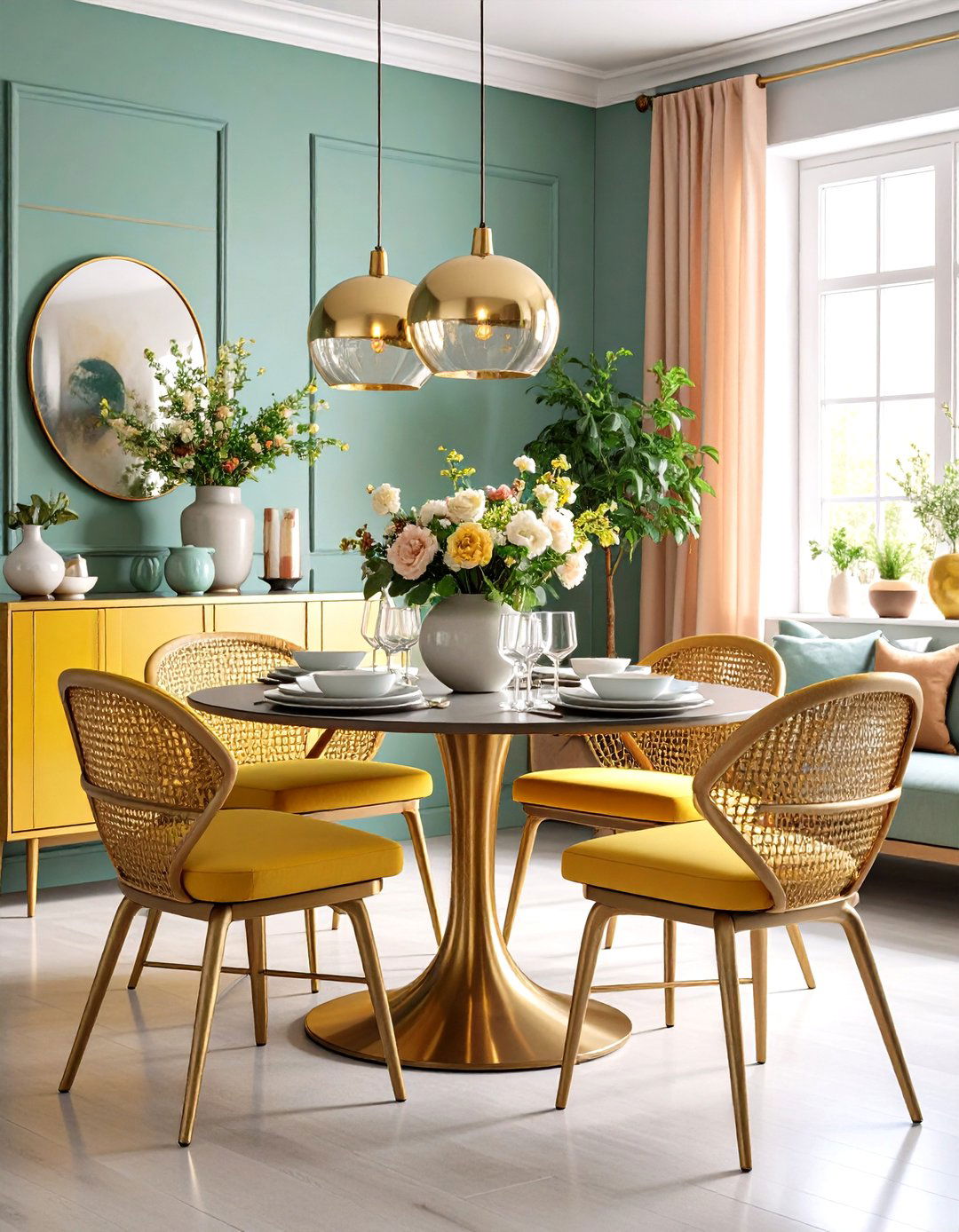
Combining contemporary silhouettes with heritage accents produces a dining room that feels both fresh and familiar. Pair a sleek metal base table with caned-back chairs, or introduce one boldly colored mid-century piece amid neutrals for punctuation. Curated eclecticism celebrates individuality while reflecting broader 2025 interest in personal narrative over catalog uniformity. Keep cohesion via a repeating metal finish or consistent upholstery tone so the room reads intentional rather than chaotic. Homes & Gardens Southern Living
20. Sculptural Table Becomes the Dining Room Centerpiece
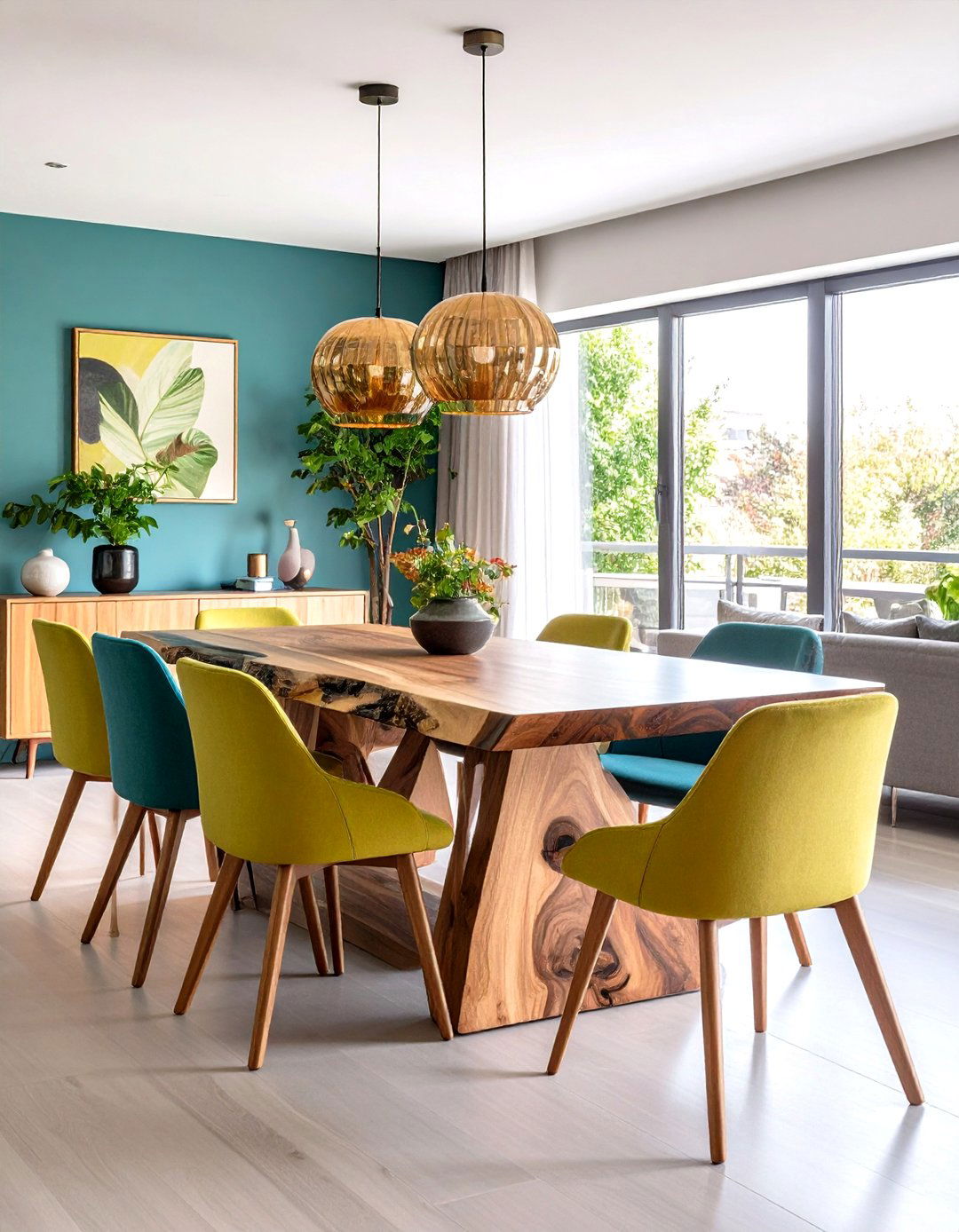
Finally, make the dining table itself the work of art. Contemporary designs feature live-edge slabs, resin-poured rivers, or geometric stone bases that command attention even when not set. Measure clearance—at least 36 inches to walls—so the striking form doesn’t hinder movement. Temper a bold table with simpler chair profiles, letting negative space highlight curves. Protective oil or resin finishes preserve craft details against daily wear, ensuring the statement lasts through family meals and festive spreads alike. Architectural Digest
Conclusion:
Intentional choices—whether eco-friendly furniture, mood-shifting lighting, or artful mismatched chairs—transform a dining room from mere eating zone into a stage for memory-making. By layering sustainable materials, expressive colors, and thoughtful tech, you craft an environment that evolves with seasons and lifestyles while always feeling authentically yours. Refer back to these twenty ideas whenever the space needs fresh energy, and let the dining room continue to nourish both body and spirit with every gathering.


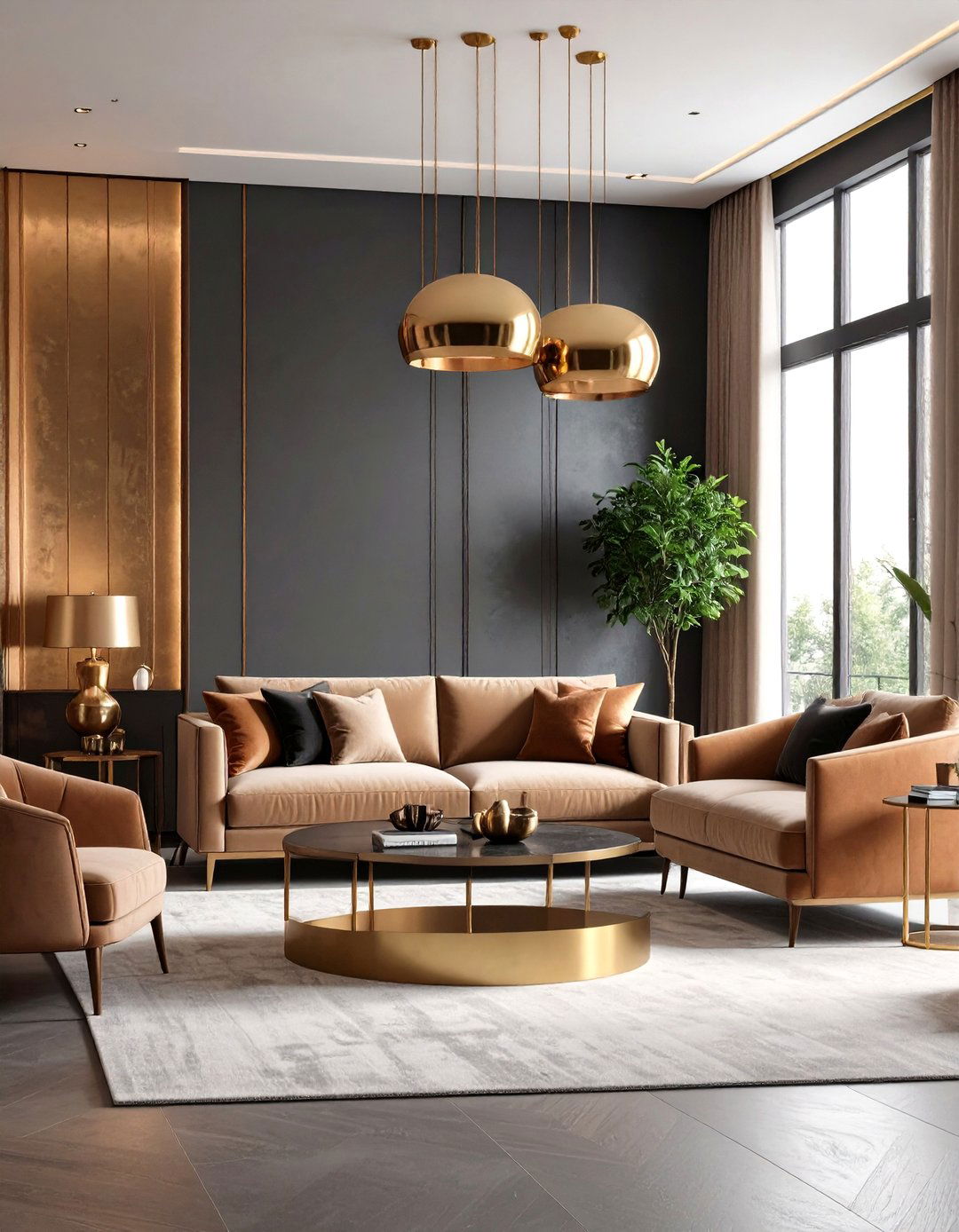



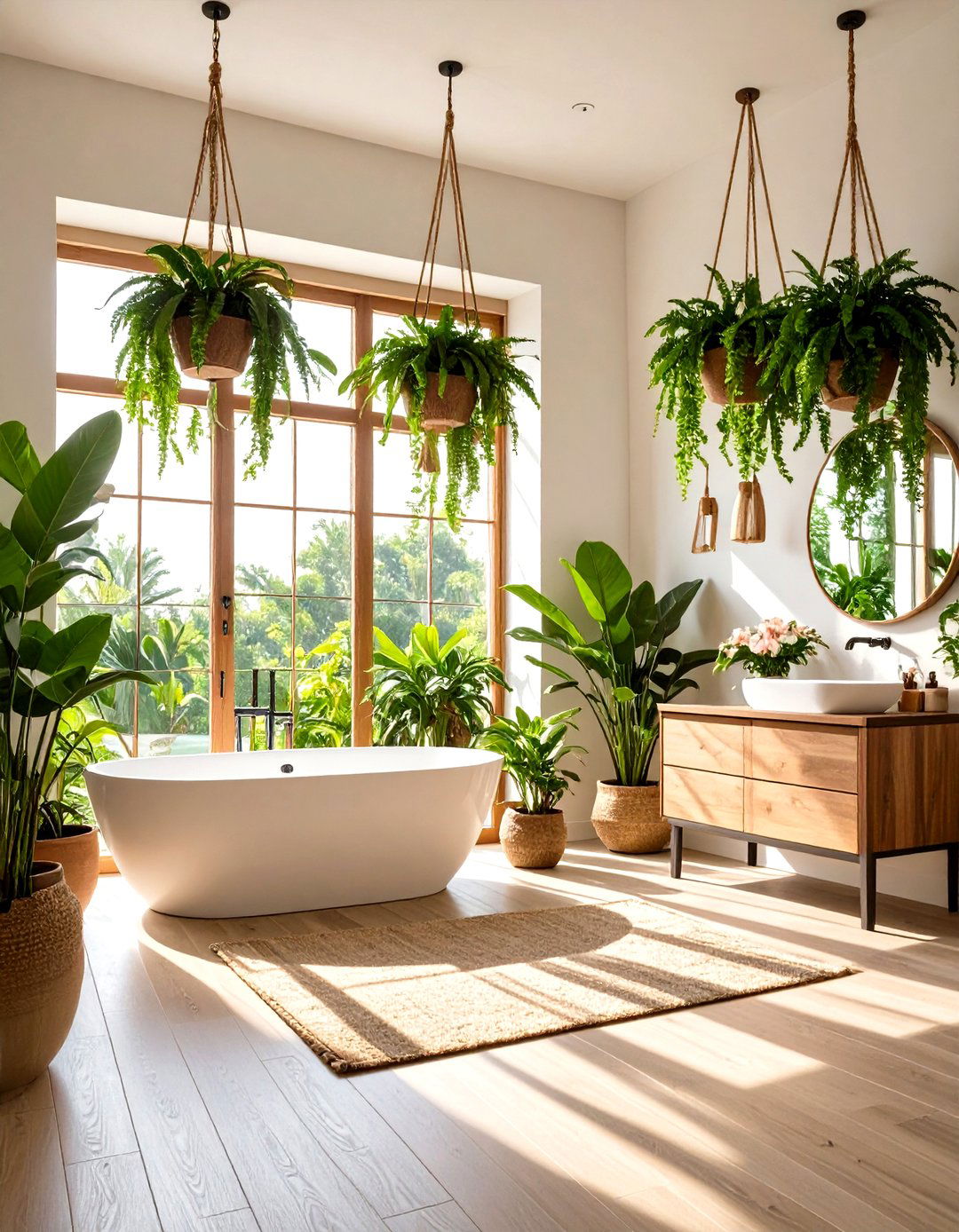
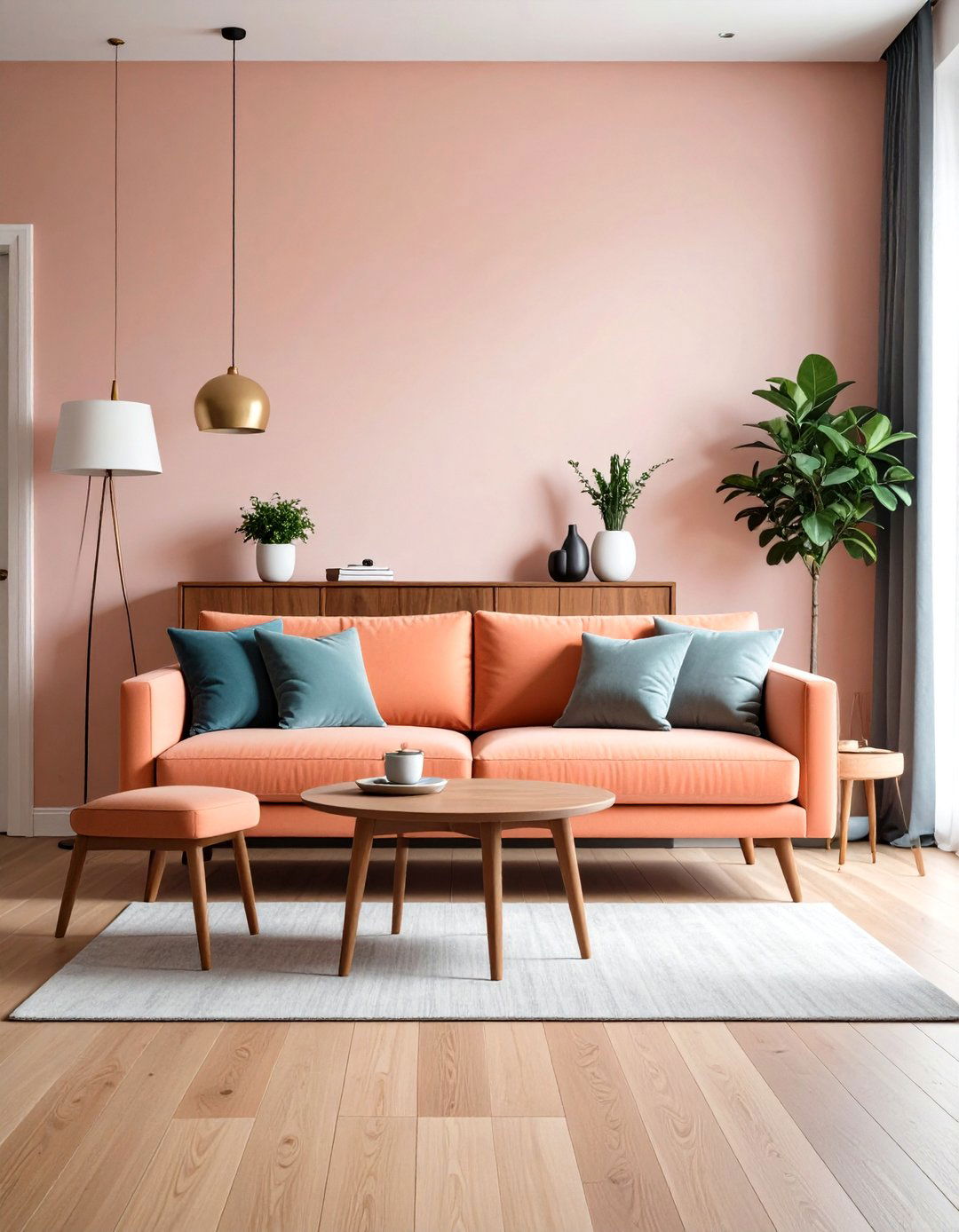
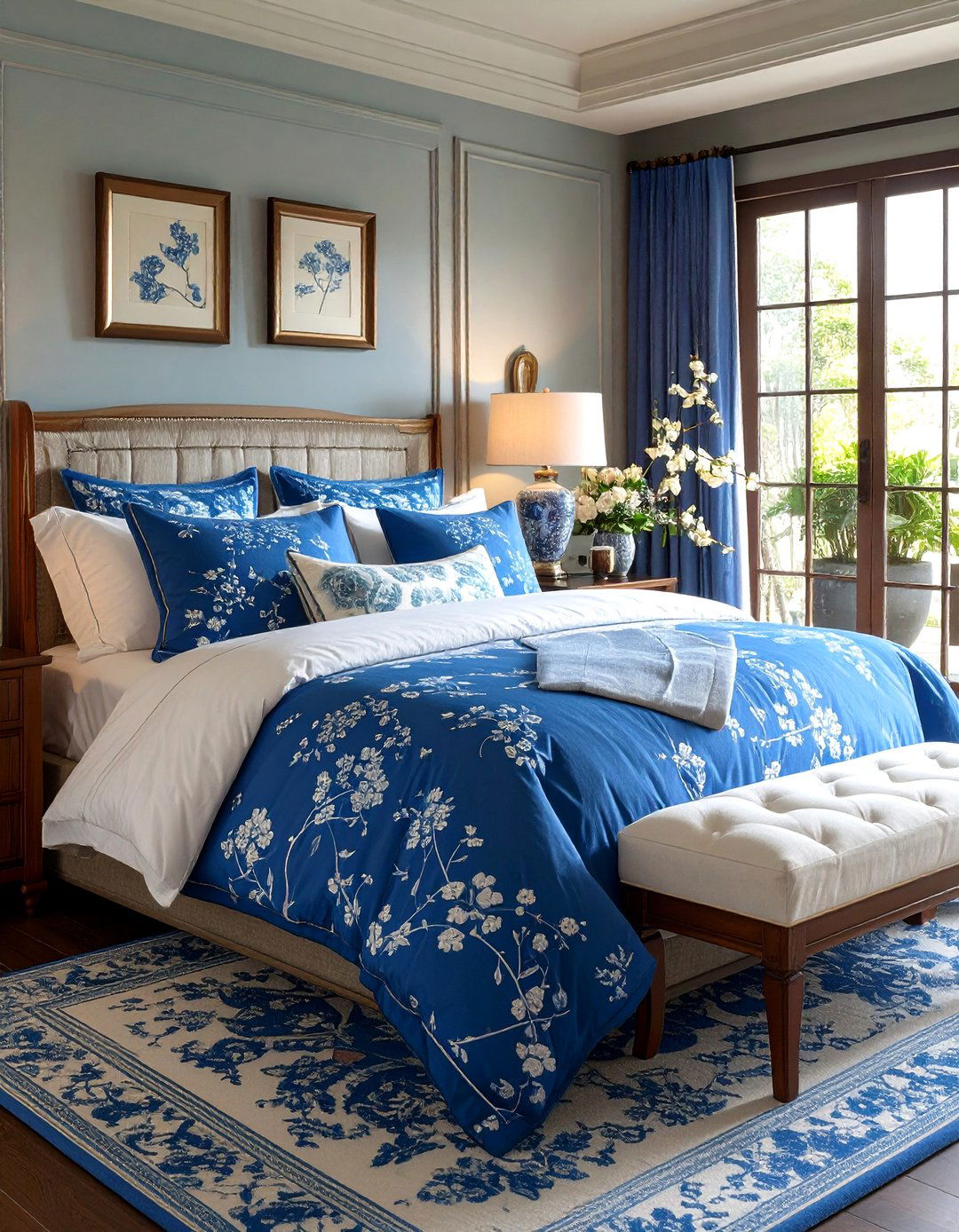
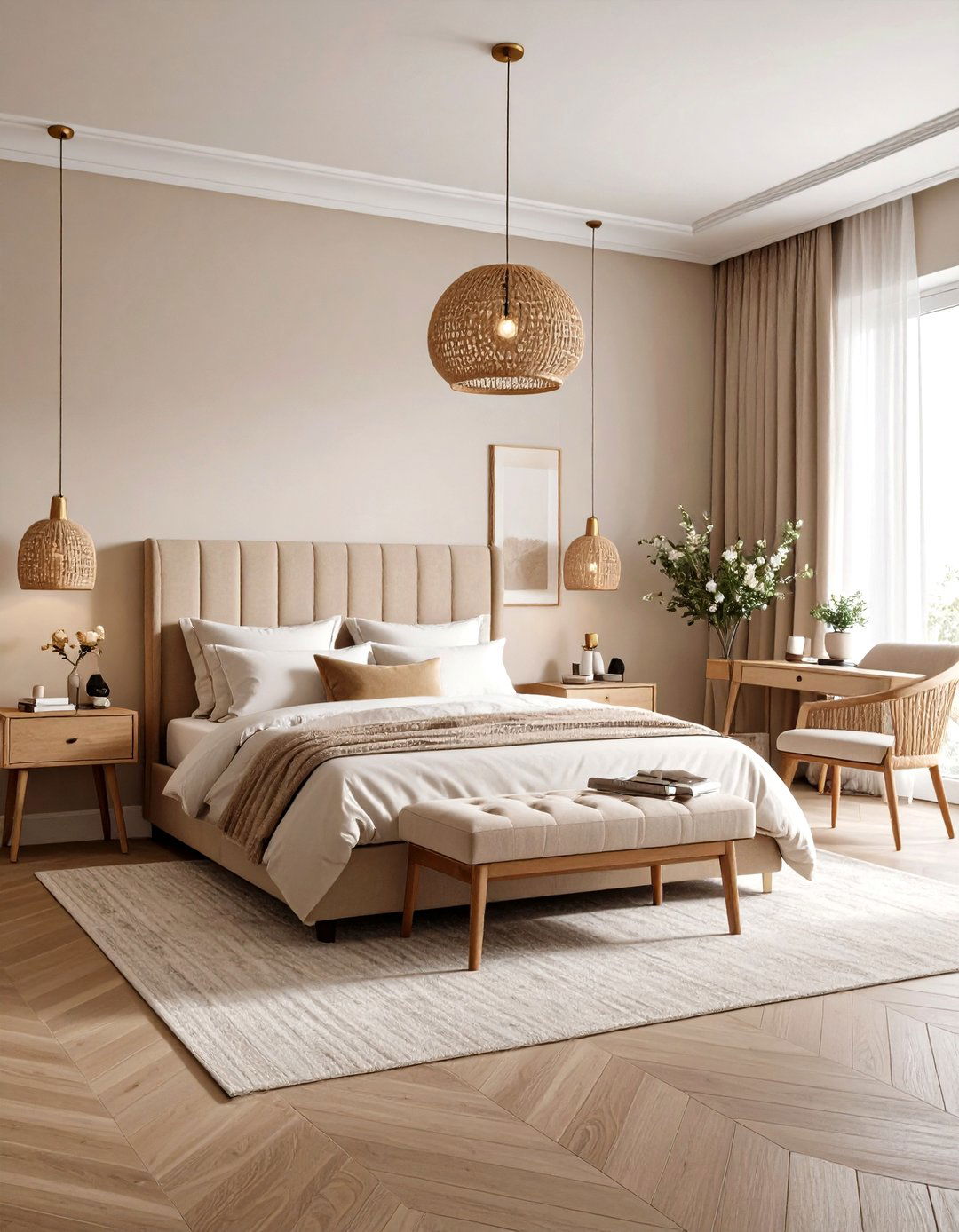



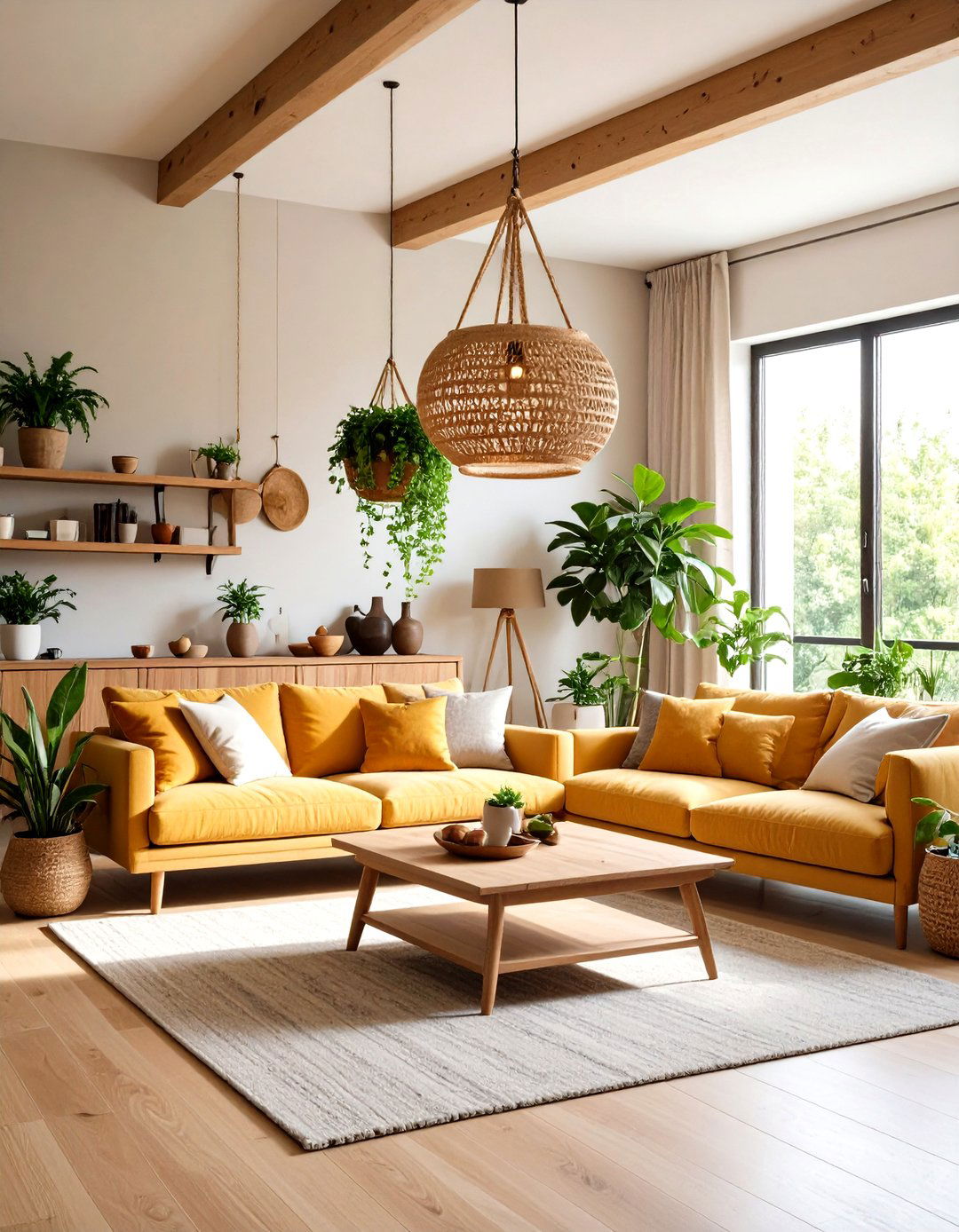
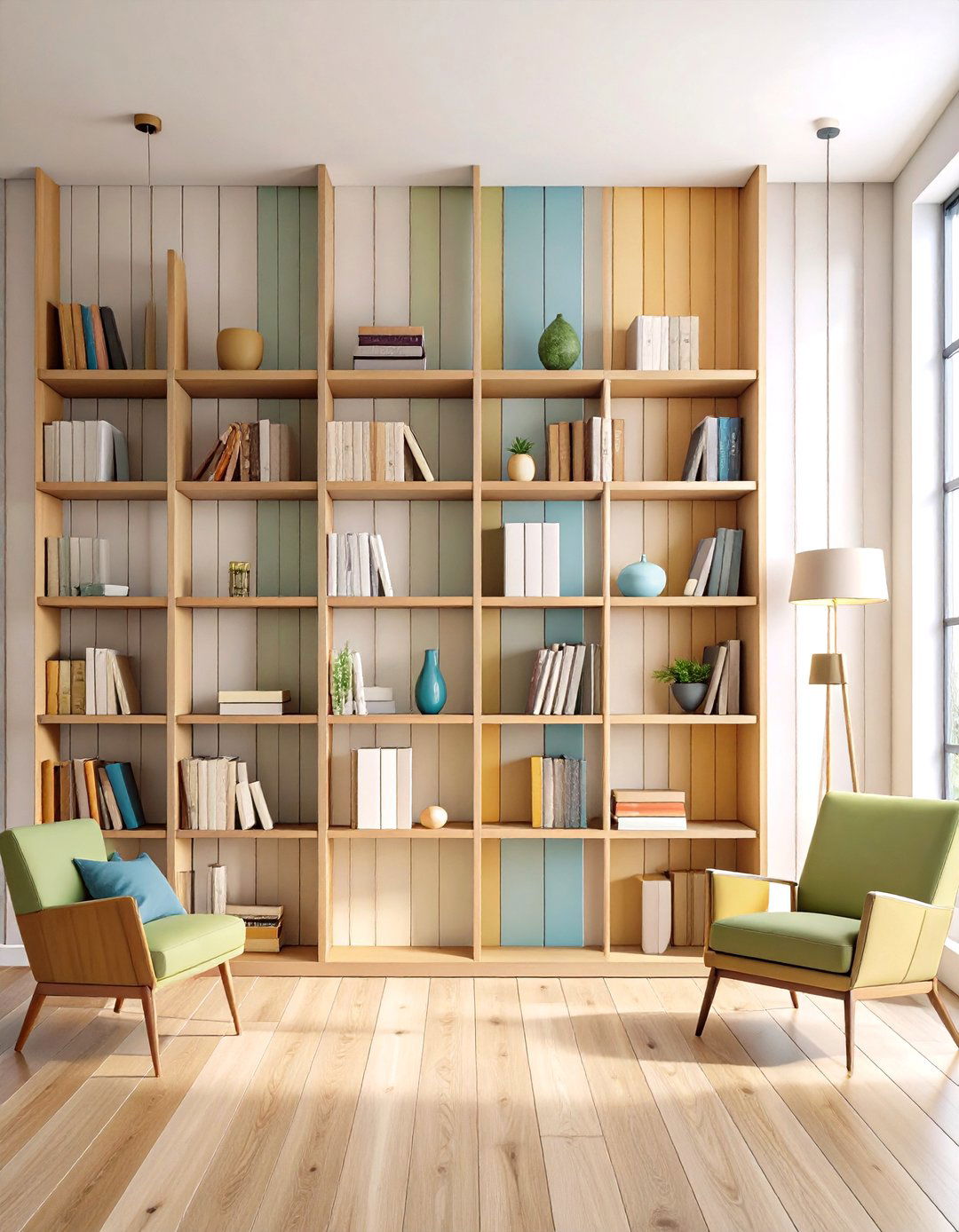

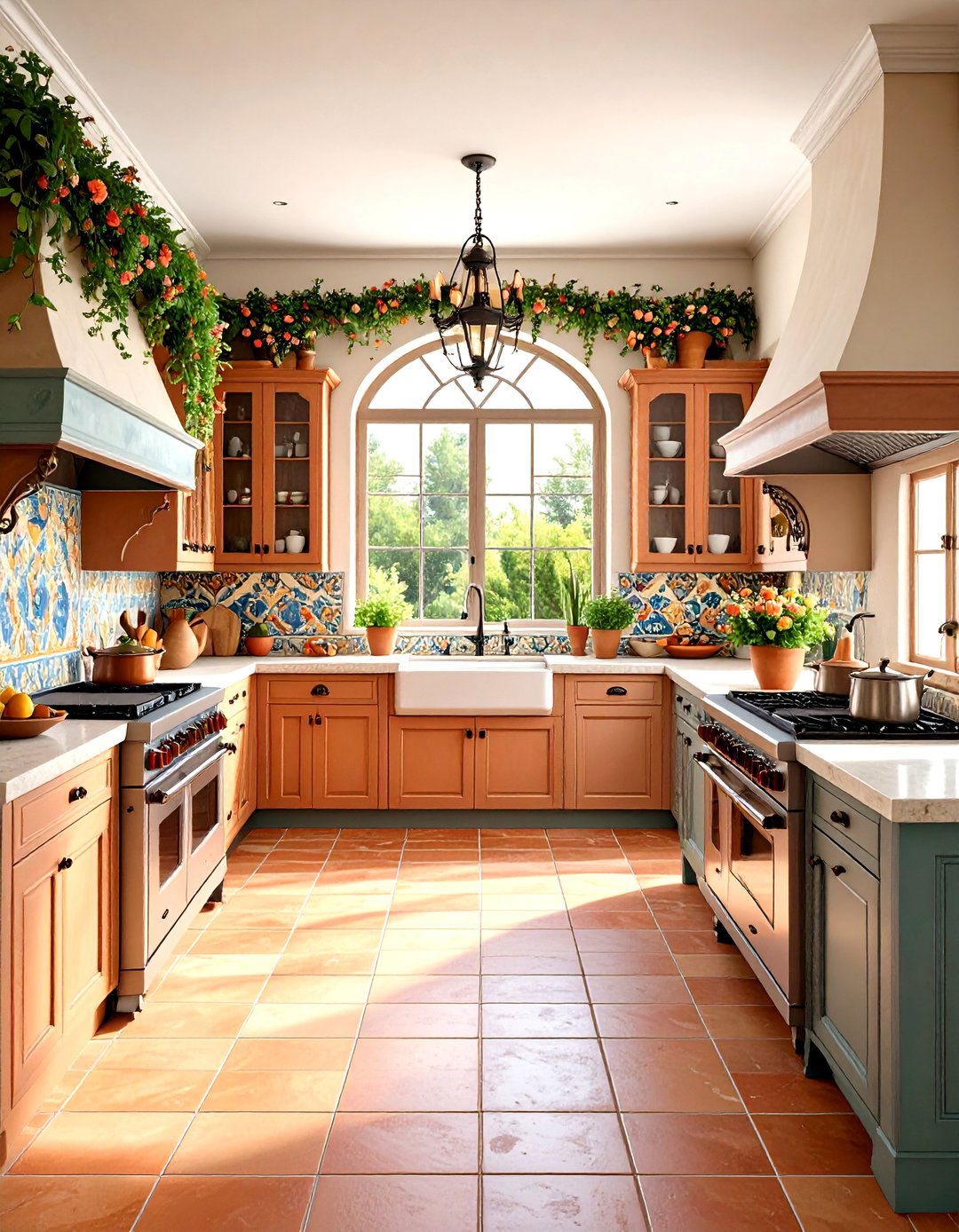
Leave a Reply